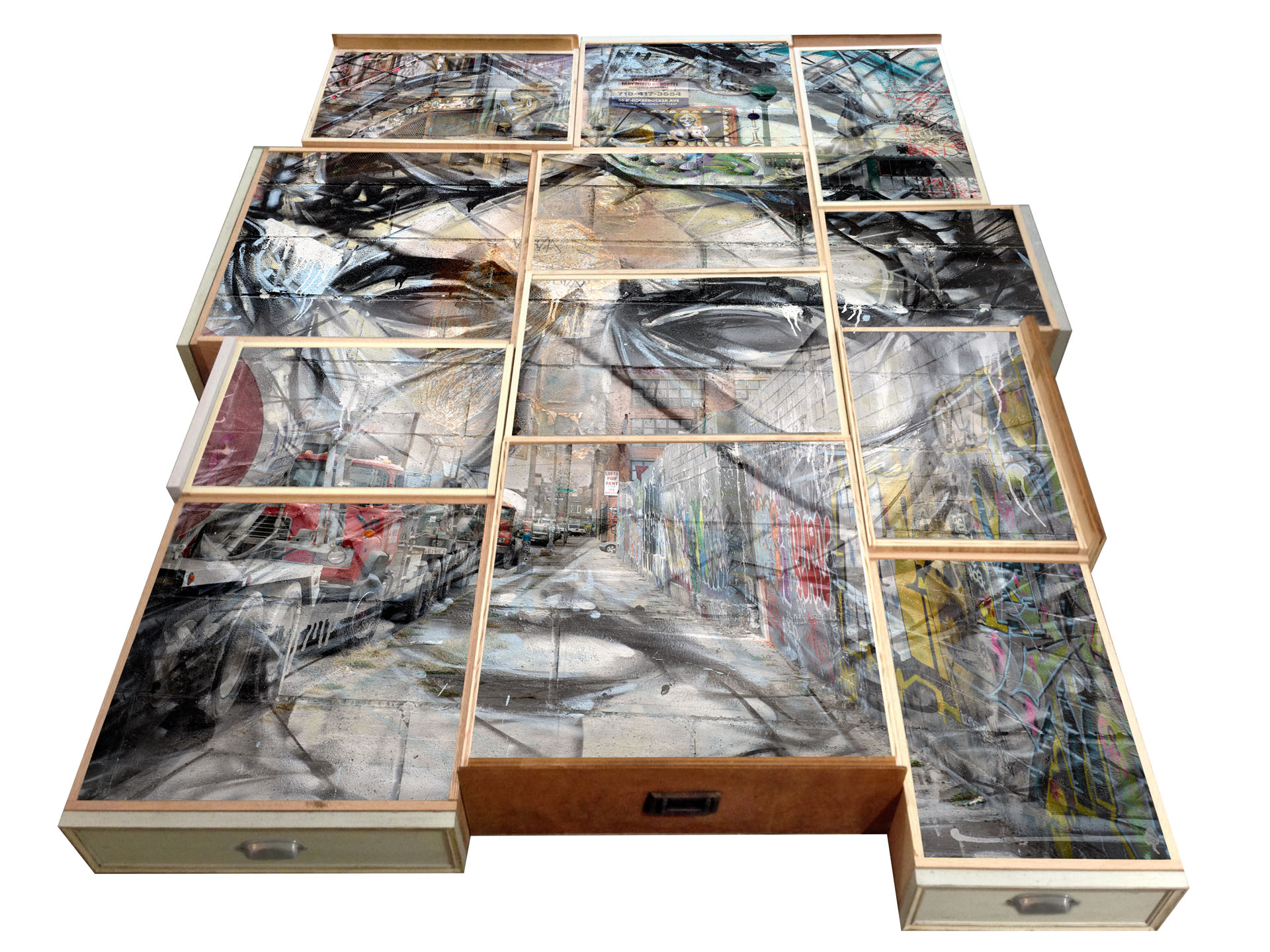





















Artist statement:
This project pays tribute to Brooklyn's former landscape, while it celebrates its constant reinvention. It mirrors my personal story, two decades ago, a new immigrant moving constantly, from Bushwick to Williamsburg following the "L" line. The accelerating and ubiquitous phenomenon of gentrification in these neighborhoods - and the fact that I since became myself one of the "gentrifiers" - challenged me to question this evolution. Brooklyn has always been a patchwork of neighborhoods, ethnic or religious communities. It is a place where immigrants settle down for the best affordable compromise - 15 minutes away from ‘the center of the world’, the capital of all aspirations - and a relatively safe place to comfortably raise their children. Density is bearable, trees are still usually higher than buildings, it is not yet just a playground for developers, high-flyers and corporations. The photographic series reveals the aesthetic shifts in the borough streetscapes as part of the gentrification phenomena. It insists on the relationship, opposite and intertwined, between the remaining edgy parts and the newly gentrified environment. It gives an absurd and surreal glimpse, at once into its past and into its future. Graffiti is present as an interesting signifier of upcoming gentrification: it offers a subcultural resistance, while simultaneously being trademarked and packaged to sell the neighborhood to the highest bidders. Still rooted in the landscape as a social indicator and a platform for discussion, still bridging my personal experience. Our cityscape evolves like a concrete jungle. In a Darwinian way, the more vulnerable are being pushed out or forced to adapt. I was one of them... until I wasn’t… We cannot stop evolution, but we should always pay attention to the cultural and socio-economical price we pay.
Press:
For more than a decade Kremer being photographing the ever changing Brooklyn landscape. Creating a comprehensive body of work that split into five parts:
Part I- Photographic Sculptures Kremer created ‘photographic sculptures’ that combine his collaged images with locally found historical photographs, doors, windows, or objects... Loosely inspired by Gordon Matta Clark, he convert old buildings parts into light-boxes and the result becomes a hybrid object, a mix of old and new, like gentrification.
Part II- follows historical investigation Covering several neighborhoods, Kremer mix historical found imagery with his photographs of today's city- scape. This spans several decades and for each street corner, gives a simultaneously absurd and surreal glimpse into its past and its future.
Part III- takes a closer look at the human repercussions. The 'locals', the neighborhood's old-timers, are disappearing (through a visual metaphor) in front of the newcomers, portraying a new sense of social alienation.
Part IV- Diptychs: Back to the same place ten years after. Kremer follow up and depict the change of specific terrains.
Part V- Perpendicular Axis Working on this project, Kremer noticed gentrification works on both axis : vertically and horizontally. Vertical: the higher the buildings, the more gentrified the neighborhood. Horizontal : new developments spread and people migrate along the ‘in towards out’ axis of the gentrifying neighborhoods.

Hasidic Jewish sitting on a bench at the waterfront promenade of what is now the Brooklyn Bridge Park... Are they looking at the promised land?... Interior shots from my current Bushwick demolished building with pigeons (doves symbolizing freedom) locked in this wooden raw walls jail.
On the right side, orange container used as public bathroom in the new pier, with the world "toilet" in all languages... including Hebrew and Yiddish. In the water, 1906 images of boats.

In the background, image depicting the Plaza in 1906. Layered with my recent photographs of the massive developments on the surrounding blocks. Contrasting the historical open space with the density of the present landscape.

Historical racial tensions and riots, police brutality.
interior shots from my building at Madison st. Bushwick. 1920s gypsies tents in Brooklyn (bottom left).

Historical images of Brooklyn (public domain, from the Library of Congress) reveal the past of today's rapidly developing landscape.

Second floor of my 1261 Madison st, building in Bushwick, after demolition in 2015.
Images of the emblematic Williamsburg Sugar Factory building during its 2016 controversial reconversion into massive luxury condominiums. 2016 artwork from the lobby of a new Williamsburg waterfront tower building.
Brooklyn Bridge and Manhattan Bridge photographs, some from 1906 and mine from 2016.
Multi ethnicity symbols with Hanukya, Christmas tree...

From the 1920s salesman bikes to the 2014 hipsters' double-high and citbikes, from the horse carriage to the car ...

Sculpture size: 80”x60”x6 1⁄2” light box.
Part I:
Photographic sculptures
Reflects my personal story. I lived in Bushwick through the course of a decade, from poor immigrant art-student to "gentrified" landlord. This made me question and challenge the ambivalence of my feelings about this transition. The resulting sculptures are a combination of my photographic images of gentrified spaces, inserted into locally found, decades-old, fixtures.Loosely inspired by Gordon Matta Clark, the object becomes a hybrid of old and new, like the gentrified landscape.These photographic sculptures are all edition of 1, unique piece.

Sculpture size: 88”x”60”x6” light box

Sculpture size: 111”x”56”x41⁄2” light box.

Part III:
Takes a closer look at the human repercussions.The 'locals', the neighborhood's old-timers, are disappearing (through a visual metaphor) in front of the newcomers, portraying a new sense of social alienation. Graffiti is present as an interesting signifier of upcoming gentrification: it reveals a sub-cultural resistance, while being trademarked and packaged to sell the neighborhood to the highest bidders.
As in my previous work, I use the landscape as a platform for discussion. While exploring Brooklyn's gentrification I point out the socio-economical consequences of a new and changing environment. Even as we expand this view to the evolution of our global world, we must pay attention to the price we pay as a society.